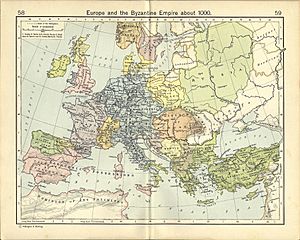AD 1000 facts for kids
The year 1000 AD was a very important time in history, often seen as the start of the High Middle Ages in Europe. It was a time of big changes and new beginnings across the world. In Europe, powerful kingdoms were growing. The Muslim world was experiencing a "Golden Age" of learning and science. In Asia, great empires like the Song dynasty in China and the Heian period in Japan were thriving.
Around the world, the total number of people was estimated to be between 250 and 310 million.
Contents
Key Events of the Year 1000
Events in Japan
- The famous Japanese writer Murasaki Shikibu began writing her masterpiece, The Tale of Genji. This book is one of the world's oldest novels.
- Ichimonjiya Wasuke, a very old Japanese sweet shop, opened its doors. It started as a teahouse near a shrine.
- On January 10, Empress Dowager Masako passed away.
- On April 8, Fujiwara no Shoshi was made Empress. This was special because there was already another empress, Fujiwara no Teishi. It was the first time Japan had two empresses at once!
Events in the Americas
- The Taíno people became the main culture in what we now call Puerto Rico. Their culture was very important in the Caribbean.
- In South America, the Wari culture and Tiwanaku cultures started to lose some of their power. Meanwhile, the Chachapoya culture and Chimú cultures began to grow stronger.
- In Central America, many big Maya cities like Palenque and Tikal were declining. But other Maya cities on the Yucatán Peninsula, like Chichen Itza and Uxmal, were building new and impressive structures.
- Mitla became a key city for the Zapotec people, influenced by the Mixtec culture.
- The cities of Cholula and Tula (the center of the Toltec culture) were flourishing in central Mexico.
Europe and Christianity
Powerful Empires in Europe
- In Europe, the Holy Roman Empire was becoming the strongest state. Its emperor, Otto III, traveled from Rome to Gniezno (in modern-day Poland). This trip included an important meeting called the Congress of Gniezno.
- In France, Robert II became the first king from the Capetian royal family.
- The Byzantine Empire in the East was fighting a long and difficult war with the First Bulgarian Empire. The Byzantines took control of some Bulgarian cities, expanding their empire.
Christianity Spreads North
- In Scandinavia, more people were becoming Christian. In the year 1000, the Althing, which was the parliament of Iceland, decided to officially adopt Christianity.
- On September 9, the King of Norway, Olaf Tryggvason, was defeated in the Battle of Svolder by the kings of Denmark and Sweden. After this, Denmark took control of part of Norway.
- The city of Oslo in Norway was founded around this time.
Norse Explorers Reach America
- Around the year 1000, a Norse explorer named Leif Erikson became the first European to land in the Americas. He reached a place called L'Anse aux Meadows in what is now Newfoundland, Canada.
New Kingdoms and Changes in the Church
- The Kingdom of Hungary was founded in 1000 as a Christian state. On December 25, Stephen I was crowned as its first king.
- Sancho III of Pamplona became King of Aragon and Navarre in Spain. In Spain, the Christian kingdoms were slowly taking back land from Muslim rule in a process called the Reconquista.
- The Republic of Venice (an Italian city-state) conquered the island of Lastovo from the Kingdom of Croatia.
- The Château de Goulaine vineyard in France, which makes wine, was founded.
The Islamic Golden Age
- The Muslim world was in its "Golden Age" of learning and discovery. It was still organized into caliphates, with the Abbasid Caliphate being very powerful.
- Muslim armies continued to expand their influence in Africa and India.
- Persia was going through some changes, with different groups breaking away from Abbasid rule. The Ghaznavids became a very strong power there.
Amazing Discoveries and Scholars
- The Islamic world was at its peak for scientific achievements. Many important scholars and scientists lived around 1000 AD.
- These included Al-Zahrawi (a famous surgeon), Ibn Yunus (an astronomer), Ibn al-Haytham (who wrote an important book about optics, or how light works), Avicenna (a famous doctor and philosopher), and Al-Biruni (a brilliant scholar who wrote about many subjects).
- By this time, many Turkic tribes from the Eurasian Steppe had moved into Eastern Europe and had become Muslim.
The Biggest Cities of 1000 AD
Here are some of the largest cities in the world around the year 1000:
- Córdoba, in Spain – 450,000 people
- Kaifeng, in China – 400,000 people
- Constantinople, in the Byzantine Empire – 300,000 people
- Angkor, in Cambodia – 200,000 people
- Kyoto, in Japan – 175,000 people
- Cairo, in Egypt – 135,000 people
- Baghdad, in Iraq – 125,000 people
- Nishapur, in Iran – 125,000 people
- Al-Hasa, in Arabia – 110,000 people
- Patan, in India – 100,000 people
Famous People Born in 1000
- June 22 – Robert I, a duke from Normandy, France.
- Constantine IX, who later became a Byzantine emperor.
- Dominic of Silos, a Spanish abbot (head of a monastery).
- Lý Thái Tông, a Vietnamese emperor.
- Sylvester III, who became a pope of the Catholic Church.
Notable Deaths in 1000
- September 9 – Olaf Tryggvason, the King of Norway.
- Abu-Mahmud Khojandi, a Persian astronomer and mathematician.
- Ibn Fadlan, an Arab traveler and writer.
- Ælfthryth, an English queen.
- Masako, a Japanese empress.
See Also

All content from Kiddle encyclopedia articles (including the article images and facts) can be freely used under Attribution-ShareAlike license, unless stated otherwise. Cite this article:
AD 1000 Facts for Kids. Kiddle Encyclopedia.

